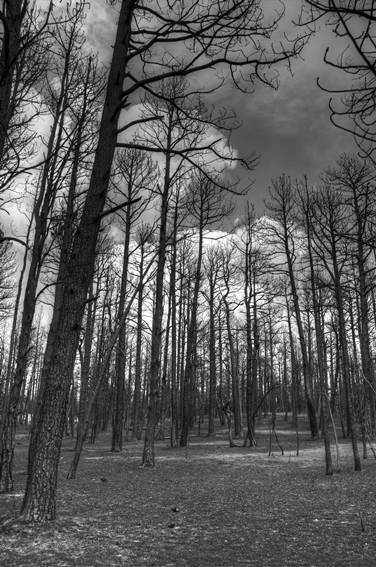
One of the most dangerous things wildland firefighters do is simply being under trees. Frequently firefighters are injured or killed after being hit by limbs or entire trees that fall. And it is not just fallers cutting down trees that are exposed to the hazards. Just last week a visitor in Yellowstone National Park was killed by a falling tree that had been a standing, dead lodgepole pine, fire-killed 26 years earlier during the park’s 1988 fires.
When I was a chain saw operator and faller on the El Cariso Hot Shots, three limbs, all about four feet long and four inches in diameter, fell out of a 36-inch diameter snag I was falling. One hit me square on the top of my aluminum hard hat, putting a sizable dent in it as I was making the final cut. I was stunned for a couple of seconds, but after I collected myself I realized that the swamper had been hit on his back by two of the limbs as he was bent over. It turned out to be a serious injury that affected him for a long time. We were lucky that the limbs were not any larger; it could have been a lot worse.
Just to illustrate the point of the danger faced by firefighters from trees, burning or not, here are some accidents we found with a quick search on Wildfire Today. This is just a partial list.
- 2007: a firefighter was killed in Florida during chain saw training.
- 2008: a firefighter was injured while falling a snag on the Rattle Fire near Toketee Falls, Oregon.
- 2011: a firefighter in New South Wales, Australia was killed by a falling tree.
- 2012: a firefighter was killed by a falling tree on the Steep Corner Fire in Idaho.
- 2013: One firefighter was killed and another was injured by a falling snag in the Deschutes National Forest near Sisters, Oregon.
- 2013: A smokejumper was killed by a falling limb while suppressing a wildfire on the Modoc National Forest in northeast California.
The U.S. Forest Service has produced a very good video titled “When a Tree Falls: Working Around Danger Trees”.

Another example of how dangerous timber, especially Lodge Pole woods can be…
Long story short. In 1988 I was scouting ahead of my Division resources on the north flank of the North Fork Fire, Yellowstone NP. Wind was minimal and in favor of our suppression task. Two mature, green Lodge Pole Pines, who’s root systems had been impacted by fire, fell, nearly simultaneously, and made an giant X right where I had been standing nano seconds before. I heard no sound in the noisy environment of the running fire (hotline) our saw teams, radio traffic and aircraft.
What warned me to run? Moving shadows of the falling trees.
Many readers may not believe that two adjacent Lodge Poles could fall simultaneously and cross their fall lines. But anyone who has worked fire in landscape dominated by Lodge Pole will know this is possible.
(Background. I don’t remember the exact date but the period was 24 July thru 12 August 1988. A bit more specifically we were three dismounted Type 3 Engine Strike Teams punching line on the north flank, anchored from cold trail near the Point of Origin, employing coyote tactics for four days and three nights. The strategery was ‘keep the fire out of the West Yellowstone community’. The tactics were parallel line with burnout. Logistic needs were served by cargo drops which the West Yellowstone Jumpers performed to near perfection.)
This video must be an update of the 1990’s video “If a Tree Falls” that starred Scott Glenn, who was the US Submarine Commander in “The Hunt for Red October.” It highlighted the fatality of a young woman on an IA fire on the Boise NF in the early 1990s, and was used in Refresher classes for many years. Has lots of application for anyone involved in fire operations like truck drivers and bus drivers who may park under dead and/or fire killed trees on the fire ground.
There’s also a good poster that MTDC produced titled “Visual Danger Tree Indicators”. It’s Order # 1167-2M13-MTDC: great visual reinforcement for crew offices, etc.
Thank you for these links, and video. These will be spotlighted this next week for our Firefighter Stand down days.
JB
British Columbia has had a very successful Danger Tree Assessment process in place for many years. There are 3 separate modules that address;
1) Harvesting & Silviculture
2) Parks & Recreation
3) Wildland Fire
It’s unfortunate that there hasn’t been any movement towards providing the US wildland firefighter with the tools and knowledge to be able to properly assess potentially dangerous trees before workers are exposed to them. Its seems that there is more emphasis put on having a good medical evacuation plan in place rather than dealing with the exposure to the hazard.
Do you still have that hard hat, Bill?
Nope, but I wish I did. Looking at the images of the broken plastic hard hats in this video, I think wildland firefighters, who are not exposed to electrical hazards, should go back to aluminum.